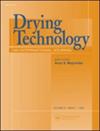Effect of the drying condition on the strength properties of Japanese larch board after vacuum heat treatment
IF 2.7
3区 工程技术
Q3 ENGINEERING, CHEMICAL
引用次数: 0
Abstract
Abstract This study aimed to investigate the effect of drying conditions on the strength properties of larch boards after vacuum heat treatment, using leftover boards from a previous study that were dried by four methods: conventional kiln drying, high-temperature drying, radio-frequency/vacuum-press (RF/VP) drying, and hot-air/vacuum drying. The boards were then heat-treated and tested for moisture content, density, bending strength, compressive strength, and tensile strength. The results showed that the drying method significantly affected the strength properties of the larch boards after vacuum heat treatment. After vacuum heat treatment, density increased in hot-air/vacuum drying and RF/VP drying, while bending strength was higher in high-temperature drying and hot-air/vacuum drying, and tensile strength was higher in hot-air/vacuum drying. Conditioning treatment after vacuum heat treatment had an impact on the decrease in density in RF/VP drying, the decrease in bending strength in hot-air/vacuum drying, and the increase in tensile strength in high-temperature drying. The drying method is a crucial factor in determining the chemical changes that occur during heat treatment, as it establishes the physical and chemical properties of the wood prior to treatment. Variations in these properties can result in different chemical transformations during the heat treatment process. Therefore, to minimize any adverse impact on the strength properties of the wood, it is necessary to carefully select an appropriate drying method before heat treatment.干燥条件对真空热处理后落叶松板强度性能的影响
本文章由计算机程序翻译,如有差异,请以英文原文为准。
求助全文
约1分钟内获得全文
求助全文
来源期刊

Drying Technology
工程技术-工程:化工
CiteScore
7.40
自引率
15.20%
发文量
133
审稿时长
2 months
期刊介绍:
Drying Technology explores the science and technology, and the engineering aspects of drying, dewatering, and related topics.
Articles in this multi-disciplinary journal cover the following themes:
-Fundamental and applied aspects of dryers in diverse industrial sectors-
Mathematical modeling of drying and dryers-
Computer modeling of transport processes in multi-phase systems-
Material science aspects of drying-
Transport phenomena in porous media-
Design, scale-up, control and off-design analysis of dryers-
Energy, environmental, safety and techno-economic aspects-
Quality parameters in drying operations-
Pre- and post-drying operations-
Novel drying technologies.
This peer-reviewed journal provides an archival reference for scientists, engineers, and technologists in all industrial sectors and academia concerned with any aspect of thermal or nonthermal dehydration and allied operations.
 求助内容:
求助内容: 应助结果提醒方式:
应助结果提醒方式:


